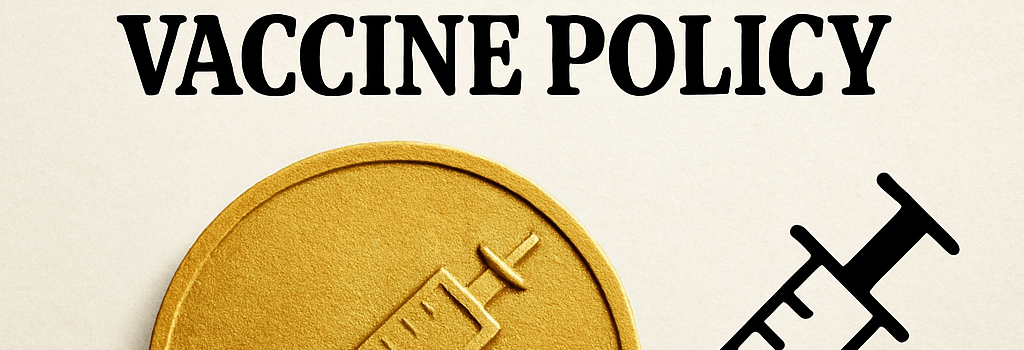The Risks of Gold Standard Science in Vaccine Policy

Introduction
On May 23, 2025, President Trump signed the “Restoring Gold Standard Science” executive order, pledging to elevate reproducibility, transparency, and conflict-of-interest controls across all federal research. At first glance, many provisions—for example, mandating preregistration of protocols and open data sharing—echo long-standing recommendations from the open science and meta‐research communities. Yet within days, the order’s rhetoric collided with real-world policy when FDA Commissioner Marty Makary described 1.8 million data points on COVID-19 vaccine safety in pregnancy as insufficient without a single randomized controlled trial (RCT). This episode lays bare how lofty standards can be weaponized.
Setting Standards in the Executive Order
The order codifies principles already endorsed by bodies like the National Academies and the International Council for Harmonisation (ICH). Key elements include:
- Reproducibility: Encouraging replication studies with shared protocols and raw data repositories.
- Transparency: Requiring public disclosure of methodologies, statistical code (e.g., R, Python scripts), and negative results.
- Conflict-of-Interest Safeguards: Mandating independent review panels and periodic disclosures per ICH E6 guidelines.
- Dissenting Opinions: Protecting researchers who challenge prevailing models, akin to the FDA’s existing Good Clinical Practice (GCP) whistleblower protections.
- Enforcement: Appointing a “Gold Standard Science Officer” in each agency—each a political appointee—charged with interpreting compliance, risk, and sanction frameworks.
Reproducibility and Open Science
Preregistration of clinical and preclinical studies on platforms like ClinicalTrials.gov or the Open Science Framework can curb P-hacking and selective reporting. The order even recommends use of version control (Git, GitLab) and containerization (Docker) to freeze computational environments. Yet, with agency budgets for original research under pressure, allocating funds for independent replication labs or long‐term data curation may prove difficult.
Transparency and Dissenting Perspectives
While the order’s call for transparency aligns with FDA’s 21st Century Cures Act initiatives on real-world evidence, its mandate to institutionalize “alternative scientific opinions” risks blurring the line between evidence-based dissent and denialist narratives. Already, climate-science skeptics and anti-vaccine advocates have seized on “dissent protections” to demand airtime for discredited theories, highlighting the fine line between legitimate peer disagreement and misinformation.
Concrete Example: FDA Vaccine Policy Shift
On June 1, 2025, during CBS’s Face the Nation, host Margaret Brennan cited a meta-analysis covering 67 observational studies and over 1.8 million pregnant women, which found statistically significant reductions in preeclampsia (relative risk 0.78, 95% CI 0.70–0.88) and neonatal ICU admissions following COVID-19 vaccination.
“COVID-19 vaccines are effective in preventing SARS-CoV-2 infection and related complications in pregnant women,” the authors concluded. “Unvaccinated pregnant women are more likely to experience hypertensive disorders and caesarean sections, and their neonates are more likely to require neonatal intensive care.”
Commissioner Makary countered: “There’s no randomized control trial; that’s the gold standard.” By dismissing high-powered, well‐controlled cohort data and large‐scale propensity-matched analyses, Makary illustrated how invoking “gold standard science” can exclude robust real-world evidence (RWE) simply because it isn’t an RCT.
Technical Challenges in Implementing Gold Standard Practices
- Statistical Power and Trial Design: Traditional RCTs require large cohorts to detect low-incidence adverse events (<0.1%), driving up costs and timelines; adaptive trial designs and Bayesian sequential analyses can improve efficiency but aren’t universally accepted.
- Data Infrastructure: Secure, HIPAA-compliant cloud platforms (AWS GovCloud, Azure Government) are needed for multi-site data sharing, yet many agencies lack standardized APIs and unified data schemas (FHIR, OMOP).
- Endpoint Selection: Surrogate biomarkers (e.g., antibody titers) are quicker to measure but may not correlate perfectly with clinical outcomes; gold standard RCTs often demand hard endpoints, delaying actionable insights.
- Resource Allocation: Funding replications competes with initiatives like AI-driven drug discovery and high‐energy physics, raising questions about prioritization in a finite budget environment.
Comparison with International Regulatory Frameworks
The European Medicines Agency (EMA) and the World Health Organization (WHO) have embraced rolling reviews and conditional approvals based on interim data, balancing speed and rigor during public health emergencies. In contrast, a strict RCT-only stance could hinder rapid deployment of countermeasures in future outbreaks. The order’s rigid definition of “gold standard” risks isolating U.S. regulators from global best practices in expedited review and post‐market surveillance.
Implications for Public Health Policy
Weaponizing “gold standard science” can undermine public trust in vaccines and therapeutics if agencies selectively ignore large‐scale observational studies. It also creates policy fragmentation: different agencies might adopt incompatible interpretations, leading to inconsistent guidance on everything from climate modeling to AI ethics. Regulatory capture becomes a real concern when political appointees without domain expertise make final calls on scientific validity.
Looking Ahead: AI, Meta-Research, and Open Repositories
Advances in machine learning can automate meta-analyses, scan protocols for p-hacking, and detect anomalies in large registries. Initiatives like the NIH’s Data Commons and Europe’s ELIXIR are building federated data hubs. If properly funded, these platforms could fulfill the executive order’s goals. However, appointing a single “gold standard navigator” per agency may bottleneck progress unless supplemented by multidisciplinary advisory committees and automated auditing tools.
Conclusion
President Trump’s “Restoring Gold Standard Science” order contains many promising elements—preregistration, open data, conflict-of-interest rules—but its real‐world impact hinges on interpretation and enforcement by politically appointed officials. Commissioner Makary’s dismissal of 1.8 million data points in the absence of an RCT serves as an early cautionary tale: without safeguards against misuse, gold standard science risks becoming a rhetorical device rather than a catalyst for more rigorous, transparent research.